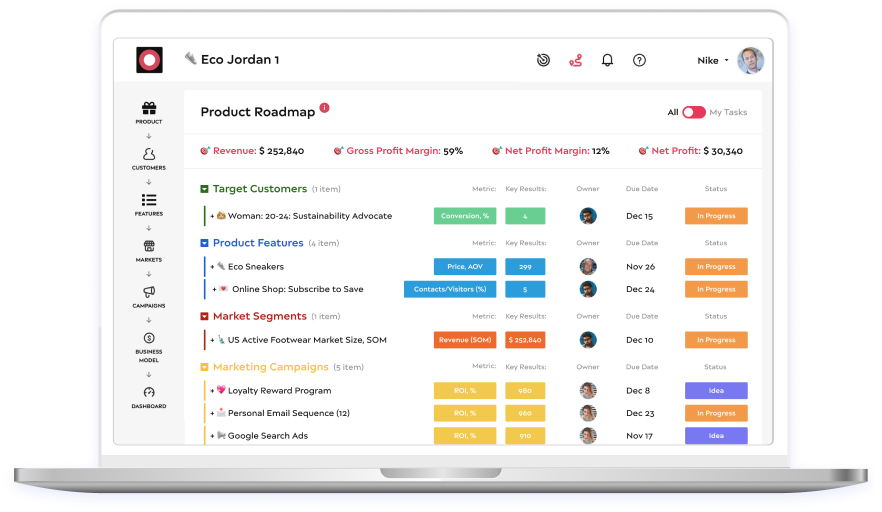Whether you’re a cosmetics brand or a supplier of novelty scarves, your long term commercial success pins on the approach you adopt when it comes to your product purchase plan.
Many modern businesses base their product planning efforts on buying inventory that’s vaguely relevant to their niche or marketplace and fits neatly into their online store’s shopping categories.
While this approach will result in some sales, without digging deeper into your market segments and working with the right data, you’ll never reach your full commercial potential. If your competitor’s are meeting the exact consumer needs of your target audience, you will eventually fall behind the pack.
To source quality products that will inspire and excite your customers while offering a consistently solid return on investment (ROI), developing a water-tight buying plan is essential.
Here we’re going to explore the importance of understanding the marketplace while offering practical tips on how to develop a successful purchase plan.
Let’s get started.
Plan product purchase order? Why knowing your market matters
In the Age of Information, consumers have access to almost infinitive information at the swipe of a screen or the tap of a keyboard.
As digital transformation drives an increasing number of retailers towards the online space, existing markets are expanding while new niches emerge. Without gaining a solid view of market segments relevant to your business, it’s unlikely you’ll source products or work with brands that will attract the right customers at the right time.
Taking an analytical approach to product and purchase order planning will help you uncover gaps in your competitors’ inventory (gaps that you can fill to attract new customers), spot emerging seasonal trends, and deliver new products that solve the problems or pain points of different customer segments.
If you take a slapdash approach to your product planning process, you’re likely to launch items that sit stagnant on the virtual shelf, wasting vital resources while offering a poor ROI. Conversely, a methodical, market-centric buying plan will boost your business’s profits by at least 34.2%.
Armed with a strategic approach to your buy plan, a sound understanding of the marketplace, and the right mix of data-driven insights, you will reap the rewards of consistent commercial growth.
Read our definitive guide to growing your revenue with market research and market segment analysis to get started.
How to create a successful product buying plan (with safety stock)
Now that you understand the important role of developing a solid purchase plan, as well as the benefits, let’s look at how to approach your product planning efforts.
Calculate the brand or market demand for your products
To source a new product, or products, that offer the best possible return on investment as well as the best rate of growth while inspiring consumers to make repeat purchases from your brand, calculating the brand or market demand for your products is vital.
Rather than taking a generic approach to your product sourcing or selection measures, you should take the time to quantify the exact market demand for your prospective choices.
For instance, if you’re a sustainable fashion brand, rather than choosing a small range of winter coats to sell during your holiday sales season, you should consider the exact brands, styles, and colors that are trending in your target markets, then make your calculations.
Once you’ve delved deeper into your seasonal target market segment and shortlisted potential products for your new lines, you can:
- Estimate the brand or product demand by looking at consumer search volumes and the size of your online market segment’s share.
- Multiply the search volume by your prospective product by 10 to get an informed projection of your potential sales volume.
Calculating your potential products’ market demand and sales potential will help you make informed choices that will likely result in profitability. You will also make decisions that result in sustainable growth.
Work out the gross margin and markup capacity of potential products
In addition to calculating the market demand and sales potential of a prospective product, working out your margins and mark up price points play an important role in the product planning process.
Calculating your products’ profitability and mark up potential boils down to two key factors:
- The price at which you can buy your product
- The price you can sell your product for competitively
Your gross margin—or gross profit margin—is based on your sales minus the cost of goods sold (COGS). A product markup is based on the difference between the sales amount of a product or service and its actual cost. Understanding your product margins and markups will tell you whether they are worth selling—this will ensure you only invest your resources in inventory that offers value to your buyers, and in turn, your business.
To understand how to calculate your profit margins and markups to increase your sales, check out our guide on what makes a profitable product.

Boost your total sales by estimating seasonal trends & demand
Another key component of a quality product plan that returns sustainable profits is analytic research based on specific seasonal trends and demands over a specific time period.
With seasonal buying trends and habits in constant motion and a wealth of annual events or holiday periods (Easter, Halloween, Thanksgiving, Christmas…the list goes on), getting to grips with emerging trends and consumer demand will put your business in the product management driving seat.
To determine your prospective products’ seasonal market demand with accuracy, you should place each item into specific market categories and arrange them according to key features, including brand, style, size, prices, and target customer segment.
Once you’ve arranged your prospective products accordingly, you can determine the seasonal demand of your products by analyzing keyword search volumes. As a general rule of thumb, the more consumers search for a product during different seasons, the higher the demand.
This approach to defining demand will not only guide you towards more profitable product purchases that will meet the seasonal needs of your customers, but it can also help you refine your market research in a way that will lead you to gaps in your competitors’ offerings—inventory gaps you can leverage to your business-boosting advantage.
In addition to methodical product categorization and seasonal keyword research, keeping your finger on the pulse of emerging trends is one of the most valuable measures you can take when it comes to product purchase planning.
Product planning is consumer-focused mainly, and here are ways you can tap into emerging seasonal trends and, ultimately, make better inventory purchases:
- Search for seasonal consumer and marketplace trend infographics, whitepapers, and studies relevant to your target market segments.
- Explore your data for previous seasons to see what types of items your target customers bought and when they bought them. Determine whether you can spot any patterns or correlations to guide your buy plan decisions.
- Gather more information on your consumers’ seasonal buying habits and preferences by incentivizing (free shipping or discount codes, for example) them to take part in polls or surveys. Use your survey results to refine your potential buy plan choices.
- Use Google Trends to identify product preferences or popular items and seasonal topics relevant to your niche or industry. Looking at regional trends will help you develop better purchasing choices based on seasons as well as geographical regions.
- Utilize your platform data to discover popular product pages or landing pages according to different seasons or months of the year.
- Sign up for your competitors’ mailing or email lists to discover what products or brands they’re highlighting and gain an understanding of what is popular in your market.
- Explore social media hashtags and trending topics to understand what products, items or conversations are trending in your niche.
Pull together your product research, data & discoveries to make informed choices
Once you’ve gathered all of the insights and information you need for your purchase plan, you can pull everything together to make your final decisions with confidence and roll out a product roadmap and plan when to place your next purchase order.

By consolidating all of your trend data, demand projections, and pricing discoveries into one accessible location, you can tap into essential insights with ease and make updates or refinements based on constant market changes.
Armed with this panoramic view of your purchase and purchase order plan, your business will become more productive, more profitable, more adaptable, and better equipped to meet the needs of your customers.
Final thoughts
“You can have data without information, but you cannot have information without data.” — Daniel Keys Moran
To consolidate your product planning efforts from idea conception to revenue and gain the level of insight required to invest in genuinely profitable brands or items, working with the right tools is essential.
Rated by the likes of Sephora, AstraZeneca, and L’Occitane, Epiprodux is a dynamic eCommerce management tool that will help you plan and validate successful products as well as marketing campaigns while gaining a deeper understanding of your customers and market segments.
Laying solid foundations for your buy plan is vital to the ongoing sales success of your business. Take measures to dig deeper into your product planning process, connect the dots together, and invest in the right tool for the job, and you will win on the commercial battlefield. We wish you the best of luck.
Read How to Effectively Implement Price Segmentation Strategies for more practical industry insights.


